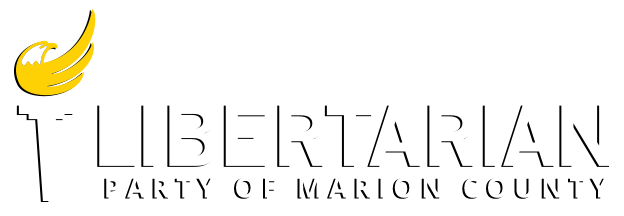By Justin Harter, Libertarian Party of Marion County Vice-Chair
Potholes are an annoying annual problem that gets people fired up. Suddenly a problem impacts people that problems don’t usually impact. Since at least Mayor Hudnut’s administration, the problem manifests in Phase 1 of the same process:
- Winter happens
- Salt, changing temperatures and water expand and contract
- Potholes appear
Then the second phase begins:
- The media makes a big deal of the potholes by finding some guy’s Volvo stuck in one on Meridian Street
- The City-County Council forms some investigatory committee
- The Mayor says there’s no money
- Spring happens and DPW patches the holes
This year is a little different because of the extreme volatility of the winter temperatures. Mayor Hogsett took $14 million and put on top of the already-allocated road funding budget.
The third and final phase of this political dance is happening now:
- The media continues to make hay over road conditions
- The Mayor convenes his own task force or coalition to think up ideas
- Residents and the media make a push for a commuter tax. Other residents and press take issue with the gas tax money.
- No ideas or actions by any commission are taken. The potholes get fixed anyway, and we all forget about it until next year
There are three things to remember about this process:
- Potholes will always happen, and they are best fixed most economically when it’s at least 45 degrees outside.
- Marion County can’t, as some think, just lay a commuter tax on people in Hamilton County. That’s a matter for the Legislature.
- Fixing this long-term is going to take a while because it took a generation to get here.
The Commuter Tax is a line not worth crossing
To expand on this, let’s start with the commuter tax idea. Proponents point out that Indianapolis is the largest metro area in the country without one. Good. We don’t need to be like everyone else in this regard. It’s a tax placed on people for the worst possible reasons. First, it’s a thin form of taxation without representation. Something we already walk the line on with the restaurant and food service tax that covers Lucas Oil Stadium in the metro area.
You can’t make an argument why a person who lives in Cicero and commutes to Kokomo — which people do — should pay to support Holt Road.
If you did make an argument for it, it would probably sound like, “Cicero’s success depends on the vitality of Indianapolis.” No, it doesn’t. Cicero, Danville, Franklin, and a bunch of other cities and towns barely in the orbit of Indianapolis don’t care. You couldn’t swing a shovel in Greenfield without hitting someone who has never been to Indianapolis, just 20 minutes the other direction.
Tolls and debt can’t finance us out of this
Marion County can’t impose tolls without Legislative approval. That’d be the ideal scenario, at least to capture revenue from actual users. Tolls would also show the exact cost to people. But if we did have tolls, it’s not likely you’ll see a booth on Keystone before you do I-70.
What’s really at hand is simple: there are a lot of people in Carmel, Fishers, Greenwood, Avon, and Plainfield that commute on Indianapolis roads daily. This is true. Those people have nice communities and must have some money; thus, we should have some of that in Marion County. This is not true.
What Carmel, Fishers, and other close suburban cities have is new infrastructure and a lot of debt. We don’t need to emulate them, either. Indianapolis has enough debt for stadiums and other subsidies already. They’re just kicking a different can down a different road than Indianapolis.
Carmel’s debt load is $1.2 billion, or about one Indianapolis Annual Budget. That’s about $13,000 per Carmel resident — kids included. Fishers’ debt load was $14 million in 2017, which consumes about 17% of their entire budget.
The suburbs are going to have the same problems in a generation that Marion County’s “original suburbs” have today. Speedway, Beech Grove, Southport, and Lawrence all have sprawling, old infrastructure from the 50’s and 60’s. Thanks to Uni-gov, so does Marion County from the 1970’s. Carmel and Fishers and others will see the same in 50 years if they don’t learn from history’s mistakes. You can’t cheaply blanket the earth with concrete and debt in one 10-year span and then wonder why it all falls apart in the same chunk of time 50 years later.
We have the money sitting in the bank — just in the wrong account
If Marion County wants to fix its roads, it’s going to have to do it with its own money. The Legislature will be unlikely to support tolls or commuter taxes since it already raised the gas tax and BMV fees in 2017. The gas tax, BMV fees, and state funding has brought in about $52 million for Marion County.
There is something the Legislature has done: turn a blind eye to TIF use. Marion County is sitting on hundreds of millions of dollars in Tax Increment Financing (TIF) districts. Originally intended as an economic development tool for putting money generated by a development — like a hotel, mall, stadium, etc. — into the area around it, they’ve become flush with funds when released to the City’s general fund. We’ve used TIF money to fund Downtown projects and IPS. You can argue TIFs shouldn’t exist, and we’d be inclined to agree. But the City has used them in the past.
Allowing TIF money to flow into a City’s general fund, even one-time, would enable the City to legally pay for its resources in ways that it sees fit to the tune of $103 million. Then come winter, we’ll have Phase 1 all over again, but Phase 2 will look a lot different.

Comments are closed.